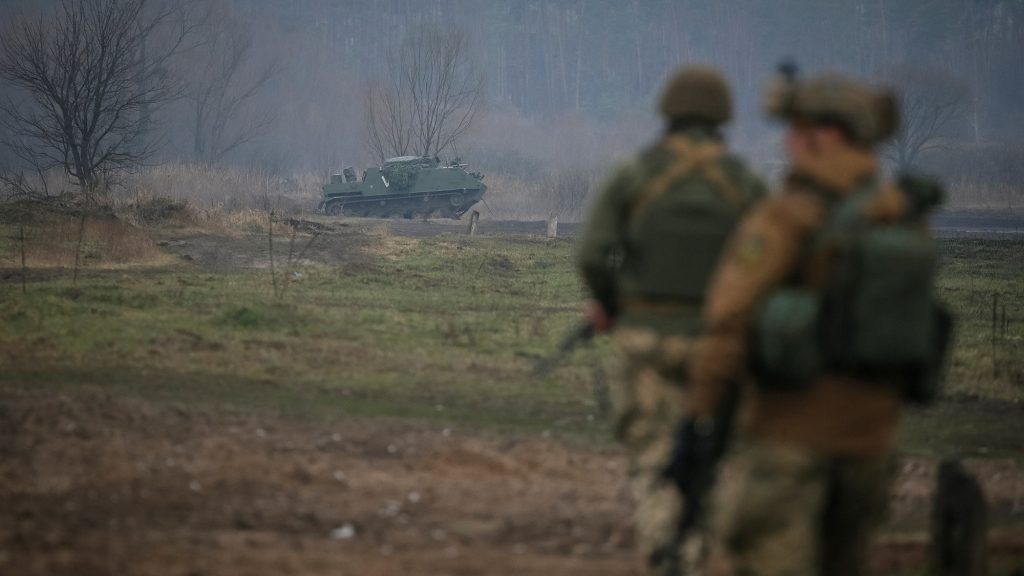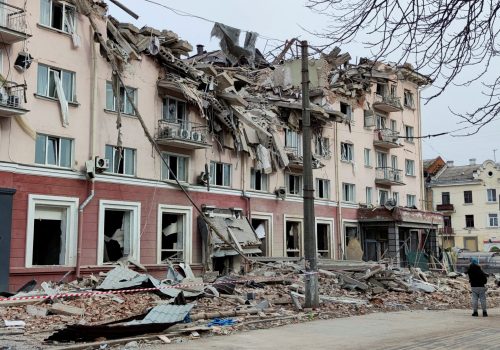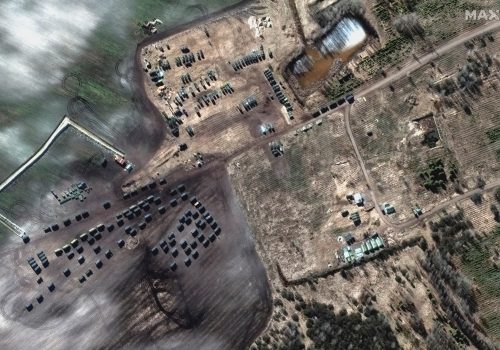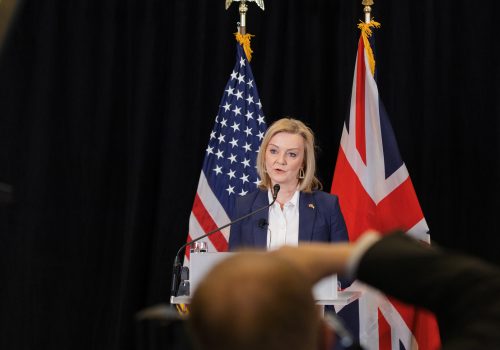In light of the ongoing Russia crisis, the Scowcroft Center’s Forward Defense (FD) practice will share weekly assessments of the latest force developments surrounding Ukraine, leveraging the expert perspectives of our senior military fellows. The opinions, conclusions, and recommendations expressed or implied here are solely those of the authors and do not represent the views of the Department of Defense or any other US government agency.
The bottom line
This week, the Russian Ministry of Defense (MoD) announced a major shift in its military strategy in Ukraine—moving from the goals of taking Kyiv and winning control of the entire country to the much more limited objective of controlling the Donbas region. We assess that this announcement is driven by circumstances on the ground, specifically Russia’s stalled offensive momentum, its massive losses of personnel and equipment, and a worsening resupply problem. In the north, Russian momentum has completely halted, and Ukraine has begun a small-scale counter-offensive to reclaim some occupied territory. Momentum is also stalling in the south, where Russian forces have virtually reduced Mariupol to rubble in an effort to end resistance in the area and complete the Kremlin’s land bridge from Crimea to the Donbas. The immediate threat of a large offensive against Odesa appears to have passed, but the city is likely to be targeted by naval fires, air, and missile strikes. Although Russia will continue air and missile strikes throughout the country, as well as use naval fires to attack cities and towns along the Black Sea coast, we believe there is very little chance of new Russian gains outside of the Donbas. Small-scale Ukrainian counter-offensives in both the north and south will begin to dislodge Russian forces from key terrain, but there is also little chance of a significant Ukrainian breakthrough this week.
Russian military movement
On March 25, Russian Army Col. Gen. Sergei Rudskoy, deputy chief of staff of Russia’s Armed Forces, announced the completion of the “first stage” of the Russian “special military operation,” signaling a shift in strategy focus toward the Donbas. Contrary to the Russian rhetoric of having completed its military objectives, we see that this change was forced on the Russian military by strong Ukrainian resistance, shocking Russian losses of personnel and equipment, stalled momentum in all areas of operations, and a continued logistics resupply problem.
Air and air defense: Russia has increased its number of airborne sorties but shifted tactics to keep its aircraft out of the threat envelope of most Ukrainian short-range air-defense systems. Thus, despite the increased tempo of Russian air operations, the rate of aircraft losses has slowed. Russia continues to signal its willingness and ability to strike targets in western Ukraine—likely a clear signal to the United States and NATO to avoid expanding their level of support for Ukraine.
- Russian Air Force changing tactics to reduce losses. Russian air activity has risen noticeably over the past two weeks, from approximately two hundred sorties per day at the beginning of March to around three hundred sorties per day this week. The coming weeks will tell whether this increase is due to an improvement in Russian supply and logistics, or just a short-term surge operation that will result in a maintenance pause causing reduced flight operations. While airborne sorties have increased, Russian aircraft losses have slowed, with only two aircraft lost in the last week. We think this is likely due to a change in Russian Air Force tactics, including the avoidance of low-altitude flying (which puts sorties within the lethal range of the Stinger man-portable air-defense system). But by dropping or launching weapons from higher altitudes and longer ranges, the Russian Air Force sacrifices its targeting precision; unfortunately, this lack of precision will add to the horrific, indiscriminate destruction Russia is imposing on major Ukrainian cities.
- Air-defense losses. Russian ground forces have lost dozens of pieces of air-defense equipment, including radars, surface-to-air missile (SAM) systems, and electronic warfare vehicles. The huge losses of mobile SAMs—thirty-seven total systems (six SA-8, six SA-13, three SA-11, five SA-17s, eleven SA-15s, and six SA-22s)—and additional equipment have contributed to Russia’s inability to establish air superiority and reduced its ability to protect its ground forces from air attack.
- Russian attack on Lviv. On March 26, as US President Joe Biden delivered a speech in Warsaw, Russia launched a missile attack on Lviv in western Ukraine. According to the Russian MoD, the attack targeted and destroyed military-supply depots in the city. We do not see this attack as a break from the overarching strategic pivot toward the Donbas, but rather a complementary signal designed to show that Russia maintains both the ability to strike anywhere in Ukraine and the willingness to strike supplies flowing into Ukraine through Lviv. This attack was likely part of an ongoing Russian messaging campaign to discourage expanded US and NATO weapon transfers to Ukraine, as we detailed in last week’s assessment. Russia has verbally threatened to strike weapons shipments, and this attack follows the March 13 Russian assault on a Ukrainian military training site near the Polish border that had previously been used by NATO forces, including US National Guard troops, to train Ukrainian forces. We believe the strike on Lviv is designed to reinforce the message to the United States and NATO that the Kremlin will not accept further NATO intervention.
Ground forces. Russia’s new strategy is aimed at massing its forces in more concentrated areas of eastern Ukraine. To achieve its goals, it is working to reconstitute its personnel losses by reorganizing existing units and sending fresh troops to backfill its Battalion Tactical Groups (BTGs). Logistics challenges continue to plague Russian forces, although its ammunition supply remains consistent.
- Russian tactics move eastward. In addition to a new focus on the east, the tactics of the Russian Armed Forces have evolved to reduce battlefield losses. Russia is conducting more reconnaissance with drones, leveraging its advantages in artillery and missiles, and improving its dug-in defensive positions with mines. While we do not know the Kremlin’s tolerance for personnel and equipment loss, Russia doesn’t appear to have reached its pain threshold yet.
- Personnel replacements. Russia is working to reconstitute its combat power by reorganizing BTGs and sending personnel replacements. Reorganizing units allows Russia to cross-level leadership and manpower across units that have taken heavy casualties. There are widespread reports that Russia is sending new soldiers to backfill losses. This will likely be prioritized to units in eastern Ukraine, based on the new strategy. The extent to which Russia pulls active-duty forces from other districts, mobilizes reserves, and enacts stop-loss on conscript service will indicate the Kremlin’s commitment to sustaining operations in Ukraine.
- Logistics obstacles. Russia continues to have difficulty sustaining its multi-pronged attacks across the country, likely contributing to its recent changes in strategy to focus its efforts on the east. Russia’s primary tank-production company, Uralvagonzavod, has reportedly run out of parts to make and repair tanks—likely an impact of Western economic sanctions. Russia is consistently supplying ammunition to sustain its artillery and long-range fires. Given the numerous reports of Russian food and fuel shortages, the Kremlin is likely prioritizing ammunition shipments.
Naval forces. Russia maintains naval superiority in the Black Sea. The Russian Black Sea Fleet’s ability to provide supporting fires and logistical support to its ground forces in the south have made it Russia’s most successful front so far.
- Ukraine continues to improvise and innovate. The Ukrainian Navy has claimed credit for destroying the Russian military landing ship Orsk while it was pier-side at the port of Berdyansk offloading armored vehicles and tanks. This marks the second Russian Navy loss in the last two weeks. Ukraine continues to demonstrate its ability to use innovative tactics and unconventional weapons effectively in naval warfare; however, neither loss to the Russian Navy will significantly hamper its operations.
- Odesa prepares for attack. Ukrainian forces in Odesa are watching the siege of Mariupol closely as they prepare for a possible Russian offensive against their largest port. Kyiv’s military is mining the beaches and arraying its forces to defend against both an attack over land and an amphibious assault. Russian troop transports and warships are currently massed off the coast. With Russia’s announcement of a shift in focus toward consolidating and holding the Donbas region, it remains to be seen if a new westward offensive toward Odesa is likely to occur soon—or whether it will only happen after Russia’s combat losses have been replaced and logistics issues resolved.
Subscribe to our weekly military assessment
Sign up for updates from Forward Defense to hear the latest on the trends, technologies, and military challenges shaping tomorrow.
US, allied, and partner deployments
NATO announces new battle groups. At the NATO Summit on March 24, Secretary General Jens Stoltenberg announced the deployment of four new NATO battle groups to Bulgaria, Hungary, Romania, and Slovakia, raising the total number of battle groups on NATO’s eastern front with Russia to eight. These battle groups typically consist of 1,000 to 1,500 troops. We predict that this relatively small deployment would be insufficient to blunt a Russian invasion of NATO territory; but it signals NATO’s determination to reinforce its eastern front, which may have a deterrent effect on Russia.
United States sending Growler electronic attack aircraft to Europe. On March 28, the US Department of Defense (DoD) announced the deployment of six US Navy EA-18G Growlers from Naval Air Station Whidbey Island to Spangdahlem Air Base in Germany. According to Pentagon Press Secretary John F. Kirby, the deployment is intended to “bolster readiness, enhance NATO’s collective defense posture and further increase air integration capabilities with our allied and partner nations.” Since the Russian military buildup began, the DoD has deployed critical air capabilities to Europe, including F-35 fifth-generation fighters, B-52 strategic bombers, F-15E Strike Eagle fighter aircraft, various intelligence, surveillance, and reconnaissance aircraft, as well as aerial refueling aircraft. These deployments have improved both the capacity and capabilities of air forces in the European theater and would very likely be able to blunt a Russian advance beyond the borders of Ukraine.
FD’s conclusion
The Russian MoD’s announcement of a shift in strategy to focus on the Donbas region was a result of the ongoing battle situation, which is characterized by a stalled offensive momentum and a serious loss of personnel and equipment. Despite the announcement, Russia is likely to continue launching air and missile attacks across the country and executing indiscriminate attacks on residential areas—resulting in the complete destruction of entire city blocks and mirroring tactics used in both Grozny, Chechnya, and Syria’s Aleppo.
In the northern area of operations, Russia will continue to bombard major cities such as Kyiv and Kharkiv but will not threaten to capture either city. Ukraine is likely to execute small counteroffensives to retake small but critical terrain. However, these attacks are unlikely to lead to any large-scale victories over Russian forces or the collapse and/or capitulation of Russian forces in the north. In the south, Russia is unlikely to conduct an offensive against Odesa, and instead will continue its effort to control Mariupol, an offensive that has devolved into a strategy of destroying the entire city. The main Russian effort is now in the Donbas, where Russia will continue to send reinforcements and resupply in the hope of building on (and consolidating) small gains on the ground with the intent of controlling the entire region and strengthening Russia’s hand in peace negotiations.
Meet the FD team
Today’s briefing is brought to you by senior US Army fellow COL Benjamin Johnson, senior US Air Force fellow Lt Col Tyson Wetzel, and senior US Marine Corps fellow Col J.B. Barranco. The Scowcroft Center Military Fellows Program, housed by the Forward Defense practice, hosts military fellows from participating branches of the US military and the armed forces of US allies and partners each year as part of a twelve-month fellowship program.
Further reading
Wed, Mar 16, 2022
Punish Putin for past and present crimes
New Atlanticist By Gissou Nia, Jomana Qaddour
Justice will remain incomplete if the dots aren't connected among Putin’s crimes in Chechnya, Syria, and Ukraine.
Mon, Mar 14, 2022
Russian War Report: Russian false-flag operation seeks to drag Belarus into Ukraine war
New Atlanticist By
Ukrainian media reported that Russia attacked a Belarusian village from Ukrainian airspace in an attempt to make it appear that Ukraine had attacked Belarus and provoke Belarusian President Lukashenka to move troops into Ukraine.
Thu, Mar 10, 2022
UK foreign minister: Putin’s invasion of Ukraine is a ‘paradigm shift on the scale of 9/11’
Event Recap By
Foreign Secretary Liz Truss warned that Putin has shaken the global security architecture by invading Ukraine and declared the "era of complacency" over.
Image: Ukrainian service members check an area near the destroyed Russian Armoured Personnel Carriers (APC) on the front line near Kyiv as Russia's invasion of Ukraine continues, Ukraine March 30, 2022. Photo via REUTERS/Gleb Garanich.



